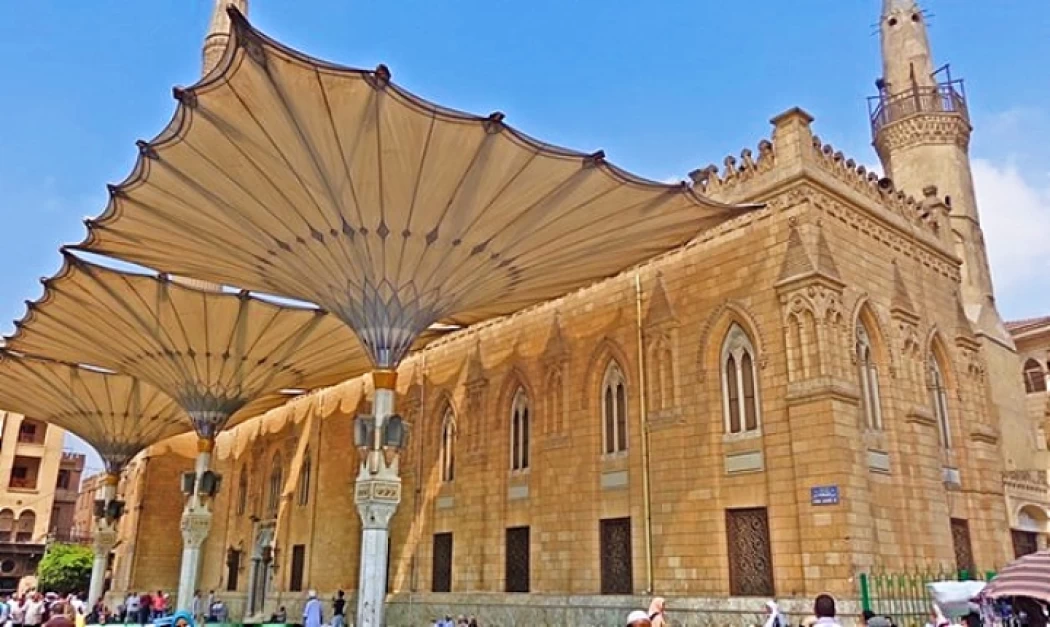
Imam Hussein mosque | Masjid Hussein Egypt
Imam Hussein mosque
Al Hussein Mosque – One of the Holiest Islamic Sites in Cairo, Egypt
Location:
Imam Hussein Mosque, is an ancient mosque situated in Cairo, Egypt, in an area known as Old Cairo or Islamic Cairo, only a short distance from downtown Cairo, near Khan al-Khalili. The Al-Hussein Mosque is one of Cairo's leading Islamic sacred sites.

Khan El Khalili
Masjid Hussein Egypt
Built in 1154 at the time of the Fatimid Caliphate. Several historical mosques, and the famous Khan el-Khalili Bazaar, where merchants have been selling their wares since the 14th century, are among the area's most prominent attractions. For example, there are many important things in the Mosque, including the oldest copy of the Holy Quran.
Description of the mosque
The Husseini Mosque is built in Gothic style with red pillars and Ottoman minarets in minaret style. They are shaped cylindrical and have 2 rounds and cone ends. On the western side of the scene are three doors; on the tribal side there is a door, and on the seaside, there is a plate where there are ablutions.
The mosque consists of five rows of arches, carrying columns of marble, and its nicely decorated feature is fine scrap, whose small pieces have been made of ceramic color instead of marble. Next to it is a pulpit, built in the wooden area of 1311 HA / 1893 AD, which is adjacent to two doors to the Dome and a second leading to the washroom.
The largest candlestick in the Arab world is inside the mosque, weighing up to five tonnes of crystal decorated with pure gold and with pure silver columns.
Hussein is the grandson of Prophet Muhammad, Hussein bin Ali bin Abi Talib. He was born in Hijra in Medina in the fourth year and grew up in prophecy. He and his family declared the place of the head of Hussein at the Hussein shrine in Cairo when he was brought from Ashkelon in 1154 A.D. on the day of Ashur in 61 H.D. and opinions were different about its place of residence.
Hussaini Masjid
Six cities have been named "Damascus – Al Raqqa – Ashkelon, Cairo – Carbals – Medina," as Ras al-Hussein is buried there.
The Husseini scene was set up in 549 AH to move Al-Hussain ibn Ali ibn Abi Talib's head and nothing is left of this now except the Bab door. In the late Ayyubid period, the minaret above the portal was built in 634 H., and only the square base remained.
Prince Abdul-Rahman renewed Ktkhda above the minaret, renovated the scene, and the dome was built at the mausoleum in 1175, adorning this dome with colorful gilded carvings from within.
When Khedive Ismail assumed power in Egypt he ordered the mosque to be renewed and expanded, which lasted ten years until its completion in 1290 except for the minaret completed in 1295 AH.
One of those that was most noticeable in the Hussaini scene is a pretty wooden sarcophagus in a room below the coffee hall, located in the middle of the dome.
King Farouk, I ordered the cathedral floor to be separated and furnished with marble in 1939 A.D., thus making the most of this opportunity to verify its existence, the Ministry of Preservation of Antiquities retrieved and reparated this cup and then transferred this cupboard to the Arab Antiquities House, when found and examined.
It is made of teak wood imported from the Eastern Indians on three sides. The faces and sides are divided into rectangles around it, separating them with Cufic lines and ornamented copies. The frames are graved. These rectangles are grouped into geometric forms, with inserts decorated in different shapes and positions with delicate plant motifs.
Good to Know
Like in all mosques, people wanting to visit the Al Hussein Mosque should dress properly/conservatively and women should also cover their hair with a headscarf as a sign of respect.
Visiting the Mosque of Al Hussein
Although a visit to this mosque is included in some of our Cairo tour packages, it is not included in all of them. However, we can include it in any itinerary of your choosing.
There are interesting things to learn about how the Egyptians celebrated their Funeral Traditions In Ancient Egypt. Some people went to Egypt and studied these traditions to find out more...
Latest Articles
Admin
Seabourn Sojourn Cruise Stops in Safaga Port
The Seabourn Sojourn, the flagship vessel of Seabourn Cruise Line's ultra-luxury fleet, was built in 2008 at the T. Mariotti shipyard in Genoa, Italy. Measuring 198 metres, it can accommodate up to 450 guests in its 225 spacious all-suite staterooms.
Admin
Norwegian Sky Cruise Stops in Safaga Port
Norwegian Cruise Line operates a cruise ship called the Norwegian Sky. It was constructed in 1999 and can accommodate 2,004 passengers in addition to 878 crew members. The ship has several dining establishments, lounges and bars, a spa and fitness center, swimming pools, and a number of entertainment areas.
Admin
Explora II Cruise Stops in Safaga Port
Explora II, the second vessel in the Explora Journeys fleet, sets sail in 2024 to redefine luxury cruising. With 461 ocean-front suites, 9 culinary experiences, and 4 pools, this haven of sophistication and sustainability promises an unforgettable "Ocean State of Mind" journey to inspiring destinations.
Admin
Mein Schiff 6 Cruise Stops in Safaga Port
The Mein Schiff 6 is the latest cruise ship in the renowned TUI Cruises fleet, offering passengers a luxurious and sophisticated cruise experience. At 315 metres long, this floating resort features a range of dining options, entertainment, and recreational facilities, including a spa, fitness centre, and sports amenities.
Admin
Mein Schiff 4 Cruise Stops in Safaga Port
When the Mein Schiff 4 cruise ship docks in Safaga, Egypt, passengers are granted access to a realm of ancient wonders. Aboard this state-of-the-art vessel, guests can embark on meticulously curated shore excursions that showcase the region's most iconic landmarks, including the Giza Pyramids, the enigmatic Sphinx, and the remarkable tombs and temples of the Valley of the Kings in Luxor.
Admin
MS Europa Cruise Stops in Safaga Port
The Silver Moon, Silversea's latest flagship, is a luxury cruise ship that offers an exceptional travel experience for Venezuelans exploring Egypt. With a capacity of 596 guests and an impressive 40,700 gross tonnes, the Silver Moon maintains the small-ship intimacy and spacious all-suite accommodations that are the hallmarks of the Silversea brand.














